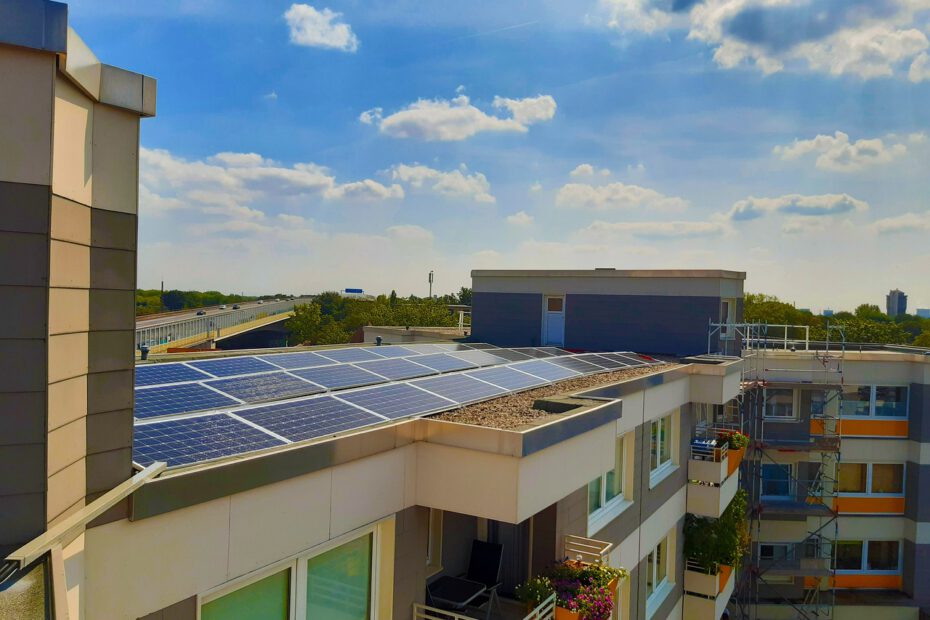In the search for sustainable solutions to reduce our environmental impact and save on electricity bills, solar panels have taken a center role. More and more people are seeking alternatives to harness solar energy, and shared apartment complexes or communities is no exception.
In this article, we will delve into the installation of solar panels and collective self-consumption, a growing trend.
What are solar panels?
Solar panels, also known as photovoltaic modules, are devices designed to capture sunlight and convert it into electrical energy. They are composed of photovoltaic cells that absorb solar radiation and transform it into direct current.
This energy can be used to power homes and businesses, reducing dependence on conventional energy sources and decreasing greenhouse gas emissions.
The rise of renewable energy
In recent years, interest in renewable energy has significantly increased. Concerns about climate change, rising energy costs, and environmental awareness have led to a surge in the adoption of technologies like solar panels. Communities are particularly interested in this option as it offers several significant advantages.
Communities and collective self-consumption
Communities, also known as residential complexes, house multiple dwellings in one place. Collective self-consumption is an innovative solution that allows these communities to benefit from shared solar energy. How does it work?
Installation of solar panels in communities
The installation of solar panels in communities is a process that requires planning and coordination. Here are some key steps in the process:
- Initial assessment: Before starting, it is essential to conduct an assessment of the community’s solar potential. This involves determining the amount of space available for panel installation and evaluating sun exposure.
- System design: Once the solar potential has been assessed, a system is designed to meet the energy needs of the community. This includes selecting the number of solar panels, the panel’s
location, and the installation of solar inverters. - Financing: Solar panel installation can be costly, but various financing options are available. This may include government grants, low-interest loans, or power purchase agreements.
- Installation: Once funding is secured, the installation of solar panels for the community begins. This involves fixing the panels on roofs or common land.
- Connection to the electrical grid: Once installed, the system is connected to the electrical grid. This allows the energy generated by solar panels to be used in community residences.
- Monitoring and maintenance: Establishing a monitoring and maintenance system is crucial to ensure the optimal functioning of the system over time. This involves regular cleaning of the panels and verifying their operation.
Advantages of collective self-consumption in communities
Collective self-consumption in communities offers several economic and environmental advantages. Some of the highlighted benefits include:
- Savings on electricity bills: By generating their own energy from the sun, communities can significantly reduce their electricity bills, representing long-term savings for residents.
- Reduction of carbon emissions: Solar energy generation is clean and does not produce carbon emissions, contributing to a reduction in the community’s carbon footprint.
- Energy independence: By relying less on conventional energy sources, communities can increase their energy independence and reduce vulnerability to energy price fluctuations.
- Increase in property value: The installation of solar panels can increase the value of properties in the community, making them more attractive to potential buyers.
- Tax incentives and grants: In many locations, there are tax incentives and grants available for communities adopting solar energy, making the initial investment pay off even quicker.
Legal considerations and regulations
Although collective self-consumption in communities offers numerous advantages, it is important to consider local and national regulations that may affect solar panel installation. These regulations vary from one place to another and may include aspects such as solar panel ownership, energy distribution, and electrical grid connection fees.
It is essential to consult with a professional or a specialized solar energy company to ensure compliance with all relevant regulations.
Steps to implement collective self-consumption
The successful implementation of collective self-consumption in communities involves several key steps:
- Community meeting and consent: It is essential to have the support of community residents.
This often involves holding meetings to discuss the project’s benefits and costs. - Selection of a solar energy provider: Choosing a trusted solar energy provider is crucial. Look for a company with experience in installing solar systems in communities.
- Assessment of solar potential: The solar energy company will conduct a detailed assessment of
the community’s solar potential to determine the necessary number of panels and optimal
locations. - Financing and legal agreements: Legal and financing agreements must be established to ensure
fair investment and a proper distribution of costs and benefits among residents. - Installation and commissioning: Once all agreements are completed, the installation of solar
panels and connection to the electrical system can proceed. - Operation and maintenance: After installation, the system requires continuous operation and
maintenance. This includes regular cleaning of panels and addressing technical issues if they arise.
Successful examples of collective self-consumption in communities.
Throughout the world, various communities have successfully implemented collective self-consumption with solar panels. Here are some notable examples:
- Example 1: Barcelona, Spain
In Barcelona, the Poblenou Solar community decided to utilize its common terrace to install a
solar energy system that would generate electricity for the building’s common areas. The project
resulted in significant savings on the electricity bill and a reduction in carbon emissions. - Example 2: San Diego, United States
In San Diego, California, an apartment complex called The Envirohaus opted for the installation
of a solar system on the roof. This system provides electricity to all units in the building and has
allowed residents to enjoy cleaner and more economical electricity. - Example 3: Berlin, Germany
Berlin is known for its commitment to sustainability, and several communities in the city have
successfully implemented collective self-consumption systems. These projects have been supported by local government through tax incentives and grants.
Challenges and obstacles
Despite the evident advantages of collective self-consumption in communities, there are challenges and obstacles that must be overcome. Some of the common challenges include:
- Initial costs: The initial investment in solar panel installation can be high, which may discourage
some communities. - Regulations and permits: Regulations and permits for solar system installation vary by location.
Bureaucratic processes can sometimes be complicated. - Continuous maintenance: Solar systems require low but regular maintenance to ensure their effectiveness. This can incude additional costs.
Solar panels and collective self-consumption in communities represent a sustainable and cost-effective solution for energy generation. As environmental awareness grows and solar technologies become more accessible, we are likely to see an increase in the adoption of this technology in communities worldwide.
If you are interested in implementing a solar energy system in your community, be sure to seek advice from experts and consider the long-term benefits.




